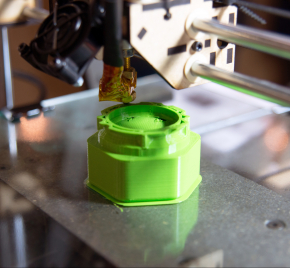How can we mitigate risk around asset downtime? What happens when OEMs or suppliers of critical materials are affected by pandemic-related issues, inflation, international conflicts, or natural disasters? Disruption has critically wounded the global supply chain network and has forced FM leaders to rethink their long-term maintenance and management strategy. While there are many ways to optimize FM operations to be more resilient and flexible in the face of disruption, supply chain technology built around FMRO (Facility Maintenance Repair Operations) is a new frontier of exploration and innovation. For SDI and our clients, the key to supporting multi-site facilities management in the ‘next’ normal’ is centered on future-proofing the parts supply chain. As digital solutions and technology continue to lead the way in supply chain digital transformation, expect more and more mature FM programs to begin to utilize 3D printing to support their FM strategy and futureproof their parts supply chain
What Is 3D Printing and How Should FMs Use It?

3D printing is the additive process of joining materials to create objects based on digital models. Think of 3D printing as one more tool in your FM toolkit. A Gartner survey of business continuity management professionals found that 3 in 4 have declared an emergency during the Covid pandemic and that in doing so, one-third experienced significant recovery problems with one or more mission-critical business processes/revenue-generating assets. What if in a similar crises-like situation, an FM was able to look at their asset register or Bill of Materials (BOM), identify critical spares and Original Equipment Manufacturer (OEM) parts that need frequent replacement, and acquired the digital models for these parts? Coupled with the right asset condition monitoring system, FM leaders could finally get into the sweet spot between preventive maintenance and predictive maintenance and maintain it.
Among the challenges FM leaders regularly face, parts management alone accounts for 25% of asset downtime. Now considering the new supply chain volatility, it can be frustrating for FMs to keep buildings operating smoothly when their suppliers don’t perform as expected in getting the right part at the right time. There is always a balancing act of carrying the right inventory, but not too much or too late. 3D printing reduces the capital tied up in your supply chain by producing parts on-demand. This ensures that the capital is available to address immediate concerns for work orders that damage brand image and revenue streams, while also reducing the amount of space needed to store parts and supplies on-site. In addition, by 3D printing critical spares, FMs can add a layer of manageable risk and reduce supplier dependency. By printing functional equivalents based on genuine OEM factory specs, FMs no longer have to fear supply chain logistics or face the pain of material shortages and unpredictable lead times. When applied with a thorough evaluation of potential supply chain partners, including a 3D printing option to support and supplement your organization’s FM parts strategy is a move worth considering to promote overall resiliency.
Think Differently and Get Started
As with any project remember to keep it simple with a narrow focus. Begin with the end in mind, that is, determine the technology that can produce your parts and which vendor or supply chain partner has the 3D printing capabilities for quality, cost-effective parts. Next, discern where 3D printing fits best and offers the most significant value in your supply chain, even if that place is not the production of finished goods. Be sure to take a good look at your parts supply chain and indirect spend. Remember to cross check purchase and works orders to understand where critical failures are happening most. Don’t worry, if this part gets a little over whelming, contact SDI and we can help make sense of your parts data and reveal the hidden savings in your parts supply chain. Lastly, build your 3D printing business case by using either in-house devices when justified or supply chain partners, but make sure you know the actual capital, engineering, and manufacturing costs.
Read our other article that goes over 3 unique scenarios where 3D printing can be used and the benefits it offers.
Our Role at SDI
As a supply chain solution services company, SDI, focuses exclusively on the management of parts and supplies that support maintenance, repair, and operating functions. Our customers are typically large multi-site organizations like national retailers, education systems – both k12 and universities, industrial and chemical manufacturers, airports, healthcare institutions, and many others across a diverse array of industry verticals.
We are a solutions and services company. We don’t sell parts and materials, rather we help our customers manage and optimize their supply chains so they buy smarter and get better outcomes concerning their maintenance perspective. We are problem solvers. People generally call us after some sort of event, for example, a health and safety event, or they have excessive asset downtime or a spike in costs that are attributable to parts. However, the recent disruptions have created an alarm and we are seeing more organizations trying to get a handle on their parts, and the systems that manage them seeking a way that mitigates risk before disruption happens.
I encourage the FM and supply chain communities to continue to explore new technology and drive forward industry 4.0 in their organizations. Keep asking the hard questions and imagine a simpler optimized process whenever possible. Remember SDI is always here to help make sense of the mess, design a custom solution and implement to drive FM performance.



